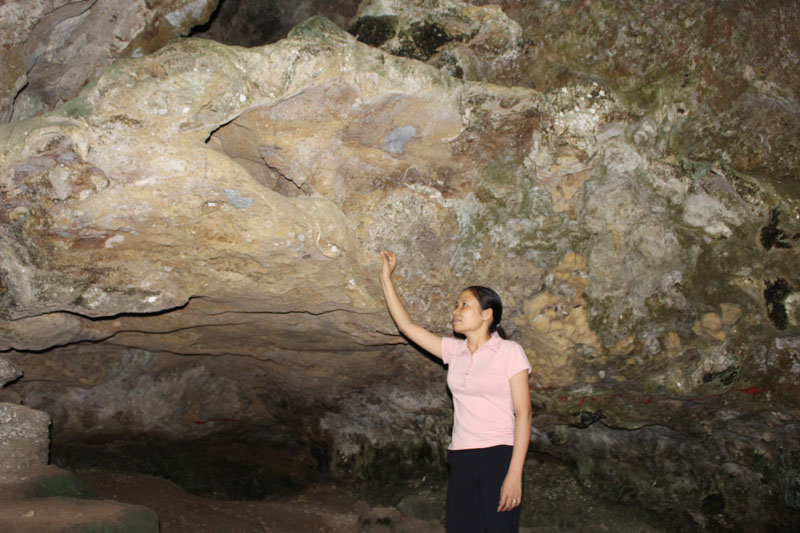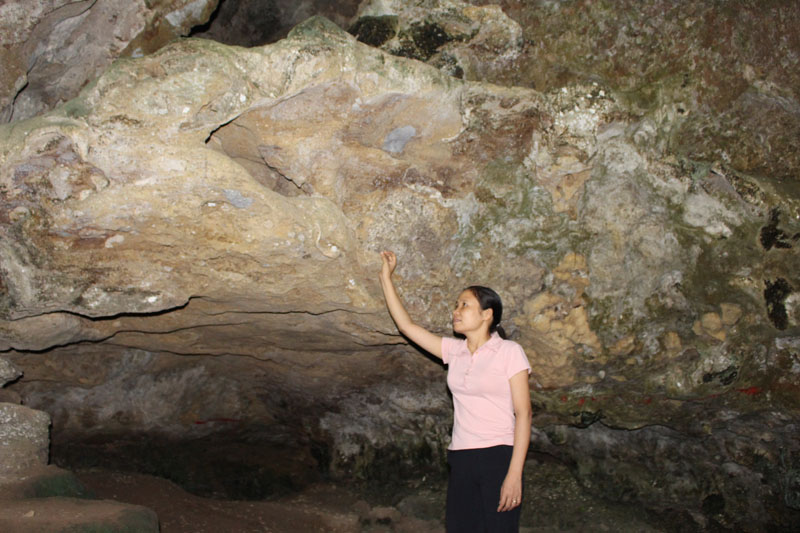
(HBO) – Cho Cave lies in the southwestern slope of Sang mountain in Hui hamlet, Cao Ram commune, Luong Son district – where a part of Hoa Binh culture inhabitants lived. In 1926, French archaeologist M.Coloni chose to unearth Cho cave relic site to study Hoa Binh culture.
Photo
caption: Residents in Cao Ram commune, Luong Son district explore Cho Cave
relic site.
Cho Cave lies in a favourable location with a wide valley having fertile
land and lush greenery all year round in front of its gate. Thanks to proximity
to water sources, it is easy to go hunting, picking fruits, seeking seafood and
herbs. For this reason, primitive inhabitants lived in Cho Cave, which was
evidenced by thick cultural layers containing molluscous feed wastes and big
sets of stone tools. With more than 1,000 artifacts on display at the Vietnam
Museum of History, the Anthropology Museum, the Vietnam Institute of
Archaeology and the Hoa Binh Museum, scientists affirmed that Cho cave is an
important archaeological relic site with great values for studies and
exploration of a famous prehistoric culture: Hoa Binh Culture.
Taking us to the unearthed areas in Cho cave, Dinh Thi Nu, a culture
official in Cao Ram commune said there are stone artifacts typical of Hoa Binh
culture such as pebble stone tools and others of oval, almond and rectangular
shape. Animal vestiges found in the cave showed that hunting was then a major
job. The main cultural layer is thick snail molluscous and clam shells. With
abundant vestiges and thorough preservation, one could imagine how the life in
the cave came along thousands years ago when holding left-over vestiges.
From such evidence, scientists believed that Cho cave dated back to 10,000
years ago and was in the period of transition to the New Stone Age.
With great values of Cho Cave, Chairman of the Cao Ram communal People’s
Committee Hoang Van Thuong said local residents are proud of Cho cave relic
site. The commune built a road leading to the cave with guards on standby. The
local people regularly come to clean up the road and grow trees in front of the
cave’s gate to attract tourists. However, the number of tourists to the site is
limited, mostly pupils in Luong Son district. Several foreign delegations came
for archeological work./.
With an increasingly vibrant and widespread emulation movement aimed at building cultured residential areas and cultured families, Yen Thuy District has been making steady progress toward improving both the material and spiritual well-being of its people, while fostering a civilized, prosperous, beautiful, and progressive community.
Once lacking recreational spaces and community facilities, Residential Group 2 in Quynh Lam Ward (Hoa Binh City) has recently received attention for the construction of a new, spacious, and fully equipped cultural house. The project followed the model of state support combined with public contributions in both labor and funding.
The "All people unite to build cultural life" movement, which has been effectively integrated with Kim Boi district’s socio-economic development goals, is fostering a lively spirit of emulation across local residential areas, hamlets, villages, public agencies, and enterprises. In addition, through the initiative, traditional cultural values are being preserved and promoted, while community solidarity and mutual support in poverty reduction and economic development are being strengthened.
A working delegation of the Hoa Binh provincial People’s Committee led by its Permanent Vice Chairman Nguyen Van Toan on June 11 inspected the progress of a project to build the Mo Muong Cultural Heritage Conservation Space linked to tourism services in Hop Phong commune, Cao Phong district.
Born and growing in the heroic land of Muong Dong, Dinh Thi Kieu Dung, a resident in Bo town of Kim Boi district, in her childhood was nurtured by the sweet lullabies of her grandmother and mother. These melodies deeply imprinted on her soul, becoming an inseparable part of her love for her ethnic group's culture. For over 20 years, this love for her hometown has driven Dung to research, collect, and pass down the cultural values of the Muong people to future generations.
In the final days of May, the Ethnic Art Troupe of Hoa Binh Province organized performances to serve the people in remote, mountainous, and particularly disadvantaged areas within the province. These were not just ordinary artistic shows, but they were the meaningful journeys aimed at spreading cultural values, enhancing the spiritual life of the people and contributing to the preservation of ethnic minority cultural identities.



